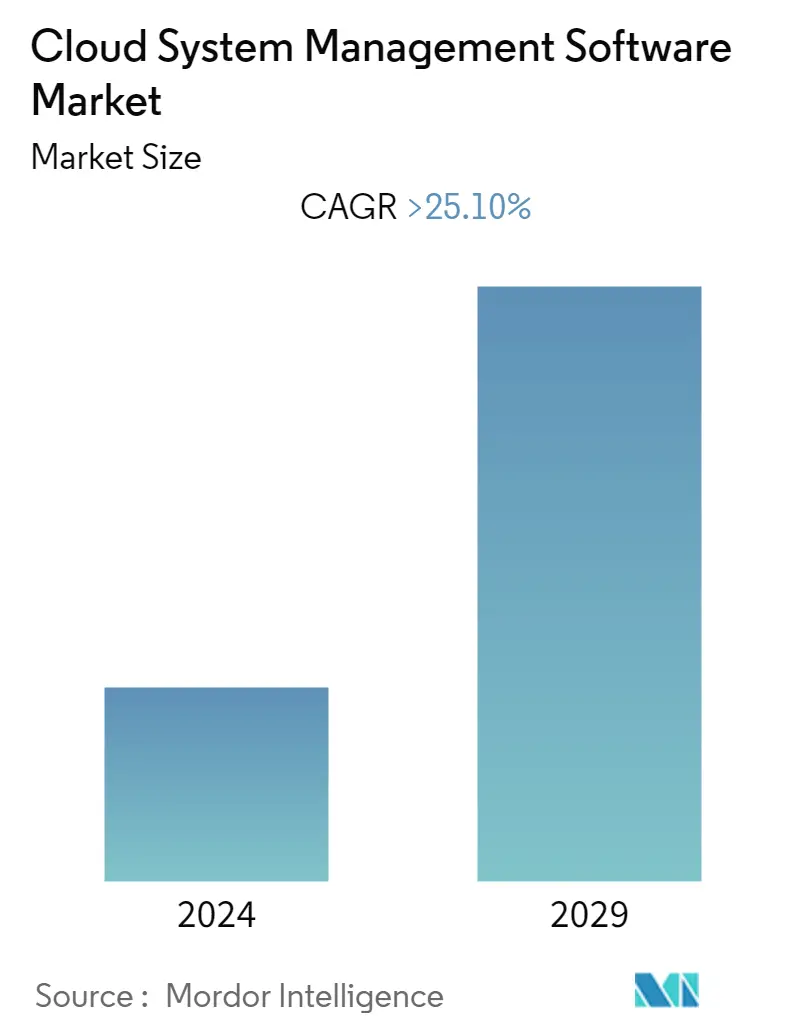Market Size of Cloud System Management Software Industry

| Study Period | 2019 - 2029 |
| Base Year For Estimation | 2023 |
| CAGR | > 25.10 % |
| Fastest Growing Market | Asia Pacific |
| Largest Market | North America |
| Market Concentration | Low |
Major Players
*Disclaimer: Major Players sorted in no particular order |
Cloud System Management Software Market Analysis
The Cloud System Management Software Market is anticipated to witness a CAGR greater than 25.1% during the forecast period. With the growth of cloud solutions and services, cloud computing technology is quickly establishing itself as the norm. Businesses and organizations no longer need to spend as much money on their own physical IT infrastructure thanks to cloud computing. Companies are compelled to shift their apps and operations to the cloud for various reasons, including the potential for significant financial savings.
- Software used to administer a cloud system is referred to as cloud system management software. This framework helps to steer the cloud's automation and operations. With a stronger emphasis on digital transformation, AI, and big data analytics, many enterprises turned to cloud services. On the other side, corporations are spending more on cloud services as they implement multi-cloud strategies and move more workloads and data there.
- Demand for the cloud system management market is being driven by the rising popularity of hybrid and multi-cloud designs, which allow for consistent building and operation across cloud, on-premises, and edge environments. Initiatives for digital transformation and optimization have benefited greatly from the cloud. Companies invest in organized innovation programs to achieve business objectives, react to market circumstances, and implement expedited digital transformation projects. As an illustration, IBM created Red Hat OpenShift, the industry-recognized hybrid cloud container technology. Users can create and access cloud services from any cloud and from any location using Red Hat OpenShift.
- The requirement to manage and execute apps through a SaaS model or manage a cloud architecture with an IaaS or PaaS platform arose as cloud software became a staple of any business IT environment. Enterprises turned to deployments between private and public, multiple public, and numerous private and public clouds as soon as Infrastructure-as-a-Service (IaaS) was introduced. As a result, the adoption of cloud system management experienced a significant landscape shift in favor of performance, cost, configuration monitoring, and analytics. Similarly, companies in the industry under investigation used strategic alliances and acquisitions to broaden their portfolios.
- Two problems that arise with multi-cloud are vendor lock-in worries and a need for more cloud spend control. Vendor lock-in refers to a situation where the cost of switching vendors is so high that the customer is essentially stuck with the original vendor because of financial constraints, a lack of workforce, or the need to prevent business operations from being disrupted, which could impede the growth of cloud system management software. Also, there is a constant risk of data breaches, which impedes industry development.
- Businesses increasingly use enterprise solutions to employ cloud-based apps to target a niche market. This adoption brought about much more substantial changes in these organizations' priorities. In addition, as the need for digital technologies increases, cloud-based apps rather than on-premise ones are more frequently used to maintain consistent enterprise business operations. Because of rising cost-cutting initiatives and pressure to produce more from IT systems and software, COVID-19 had a considerable impact on the global market. The cloud software segments were consequently looking toward SaaS delivery models with proactive and predictive optimization capabilities, enhanced application performance, and robust cost control due to COVID-19.
Cloud System Management Software Industry Segmentation
Software and technologies used together to manage cloud systems are called cloud management software. For enterprises that depend on meeting business needs, it provides flexibility to manage, monitor, and enhance resource management. Events and Incident Management, Issue Management, and Application Performance Management are examples of solutions. Managed and professional services are taken into consideration.
The Cloud System Management Software Market is segmented by Component (Solution and Services), Deployment Model (Public, Private, and Hybrid), Enterprise Size ( Small and Medium Enterprise and Large Enterprise), End-user Industry (BFSI, Healthcare and Life Sciences, Retail and Consumer Goods, IT and Telecommunication, and Media and Entertainment) and Geography. The market sizes and forecasts are provided in terms of value (USD million) for all the above segments.
| By Component | |
| Cloud IT Operations Management | |
| Cloud IT Automation and Configuration Management | |
| Cloud IT Service Management |
| By Deployment Model | |
| Public | |
| Private | |
| Hybrid |
| By Organisation Size | |
| Large Enterprises | |
| Small-Medium Enterprises |
| By End-user Industry | |
| Healthcare | |
| Banking and Financial Services | |
| Retail and Consumer Services | |
| Manufacturing | |
| Transport and Logistics | |
| Media and Entertainment | |
| IT and Telecommunication | |
| Other End-user Industries |
| Geography | |||||||
| |||||||
| |||||||
| |||||||
| |||||||
|
Cloud System Management Software Market Size Summary
The Cloud System Management Software Market is experiencing rapid growth, driven by the increasing adoption of cloud solutions and services. As businesses shift from traditional IT infrastructure to cloud-based systems, the demand for software that manages and automates cloud operations is rising. This shift is largely due to the financial savings and operational efficiencies that cloud computing offers. Companies are increasingly adopting hybrid and multi-cloud strategies, which require robust management tools to ensure seamless integration and operation across various environments. The focus on digital transformation, artificial intelligence, and big data analytics further propels the market, as organizations seek to leverage these technologies to enhance their business processes and decision-making capabilities.
The market is also influenced by the need for effective management of cloud-based applications and infrastructure, particularly in sectors like banking and financial services, where data monetization and compliance with regulations such as GDPR are critical. The COVID-19 pandemic has accelerated the shift towards cloud-based solutions, as organizations seek to maintain business continuity and optimize costs. Regions like Asia-Pacific are witnessing significant growth due to increased IT spending and the adoption of cloud technologies. Key players in the market, including IBM, Microsoft, and VMware, are continuously innovating and expanding their offerings through strategic partnerships and acquisitions, further driving the market's expansion.
Cloud System Management Software Market Size - Table of Contents
-
1. MARKET DYNAMICS
-
1.1 Market Overview
-
1.2 Market Drivers
-
1.2.1 Emerging Technologies Investing into Advanced Data Centers
-
1.2.2 IT Companies Turning to BYOD and CYOD Systems Create Demand for Cloud Management Services
-
1.2.3 Adoption of Multi-cloud Platform
-
-
1.3 Market Restraints
-
1.3.1 Data Privacy and Security Concers
-
1.3.2 Increased Cyber Attacks
-
-
1.4 Industry Value Chain Analysis
-
1.5 Industry Attractiveness - Porter's Five Forces Analysis
-
1.5.1 Threat of New Entrants
-
1.5.2 Bargaining Power of Buyers/Consumers
-
1.5.3 Bargaining Power of Suppliers
-
1.5.4 Threat of Substitute Products
-
1.5.5 Intensity of Competitive Rivalry
-
-
1.6 Impact of COVID-19 on the Market
-
-
2. MARKET SEGMENTATION
-
2.1 By Component
-
2.1.1 Cloud IT Operations Management
-
2.1.2 Cloud IT Automation and Configuration Management
-
2.1.3 Cloud IT Service Management
-
-
2.2 By Deployment Model
-
2.2.1 Public
-
2.2.2 Private
-
2.2.3 Hybrid
-
-
2.3 By Organisation Size
-
2.3.1 Large Enterprises
-
2.3.2 Small-Medium Enterprises
-
-
2.4 By End-user Industry
-
2.4.1 Healthcare
-
2.4.2 Banking and Financial Services
-
2.4.3 Retail and Consumer Services
-
2.4.4 Manufacturing
-
2.4.5 Transport and Logistics
-
2.4.6 Media and Entertainment
-
2.4.7 IT and Telecommunication
-
2.4.8 Other End-user Industries
-
-
2.5 Geography
-
2.5.1 North America
-
2.5.1.1 United States
-
2.5.1.2 Canada
-
2.5.1.3 Mexico
-
2.5.1.4 Rest of North America
-
-
2.5.2 Europe
-
2.5.2.1 United Kingdom
-
2.5.2.2 France
-
2.5.2.3 Germany
-
2.5.2.4 Russia
-
2.5.2.5 Rest of Europe
-
-
2.5.3 Asia-Pacific
-
2.5.3.1 China
-
2.5.3.2 India
-
2.5.3.3 Japan
-
2.5.3.4 Australia & New Zealand
-
2.5.3.5 Rest of Asia-Pacific
-
-
2.5.4 Latin America
-
2.5.4.1 Brazil
-
2.5.4.2 Mexico
-
2.5.4.3 Rest of Latin America
-
-
2.5.5 Middle-East and Africa
-
2.5.5.1 United Arab Emirates
-
2.5.5.2 Saudi Arabia
-
2.5.5.3 South Africa
-
2.5.5.4 Rest of Middle-East and Africa
-
-
-
Cloud System Management Software Market Size FAQs
What is the current Cloud System Management Software Market size?
The Cloud System Management Software Market is projected to register a CAGR of greater than 25.10% during the forecast period (2024-2029)
Who are the key players in Cloud System Management Software Market?
IBM Corporation, Microsoft Corporation, Vmware Inc., BMC Software Inc. and Cisco Systems Inc. are the major companies operating in the Cloud System Management Software Market.

